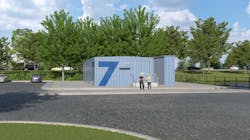Energizing the Hurontario LRT using traction power substations
Metrolinx’s Hurontario light-rail transit (LRT) line will feature electrically powered light-rail vehicles, requiring 13 traction power substations (TPSS) to be built to ensure a consistent level of power to keep the line running smoothly.
TPSS’s are small steel buildings, similar in size to a shipping container, and are used to convert alternating current (AC) electricity from the local power supply to direct current (DC) electricity to generate consistent power to operate the light rail vehicles.
They are regularly used for LRT projects and can be found in neighborhoods throughout North America. For instance, they are used in Toronto to power the TTC lines.
The Hurontario LRT’s TPSS will be constructed to comply with Health Canada’s standards, which means the inclusion of many features which are designed with safety in mind, including:
- All electrical equipment in a TPSS is enclosed within a locked building, which provides security and absorbs sound.
- Unlike typical utility transformers that use oil for electrical insulation, the power transformer in a TPSS is a dry type, which means that it will not leak or catch fire.
- All TPSSs receive regular site maintenance visits to ensure everything is operating properly.
How does the installation work?
The first step is the site preparation which includes environmental measures such as erosion and sediment control fencing to protect water quality in nearby bodies of water, and temporary fencing to keep the site secure.
The site will also be made level, making it ready for the construction phase.
After the site preparation, construction crews will then install the duct banks that will connect the TPSS to the rail line. Following installation of the underground duct banks, construction crews will build the concrete slab which will anchor the prefabricated TPSS units within the site.
After the prefabricated TPSS unit has been installed and secured on site, crews will clean up the site and install the power cables. The power cables not only provide the LRT with electricity, they also help monitor performance and maintenance issues.
Site restoration work includes landscaping (planting trees, shrubs and laying sod), hardscaping (creating a turf stone driveway, perimeter curb, asphalt driveway and sidewalk rebuild) and TPSS unit architectural finishes, like cladding.
The construction for the TPSS sites will begin towards the end of the year and are anticipated to be done by fall of 2024.
